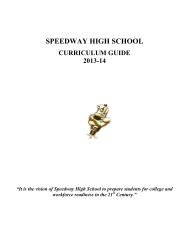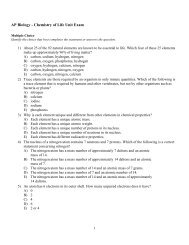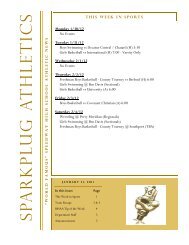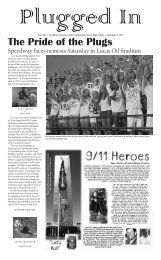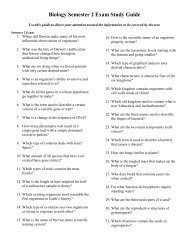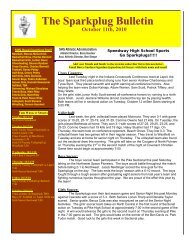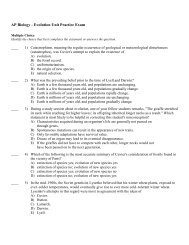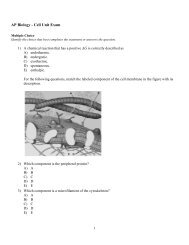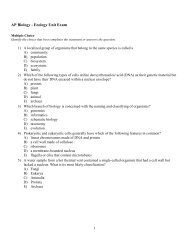ExamView - Fall Semester Final Exam Practice Test.tst - Biology
ExamView - Fall Semester Final Exam Practice Test.tst - Biology
ExamView - Fall Semester Final Exam Practice Test.tst - Biology
- No tags were found...
You also want an ePaper? Increase the reach of your titles
YUMPU automatically turns print PDFs into web optimized ePapers that Google loves.
15) Exploring how indoor air pollutants lead to respiratory problems is an example of using biology toA) develop biotechnology.B) monitor global change.C) improve human health.D) make ethical decisions.16) The smallest basic unit of matter is theA) molecule.B) atom.C) compound.D) cell.17) Which of the following is formed when an atom gains or loses electrons?A) elementB) compoundC) moleculeD) ion18) Atoms in molecules share pairs of electrons when they makeA) covalent bonds.B) ionic bonds.C) hydrogen bonds.D) polymers.19) What gives water many properties that are important to living things?A) temperatureB) hydrogen bondsC) densityD) specific heat20) Which of the following solutions has the highest H ion concentration?A) a solution with a pH of 1B) a solution with a pH of 4C) a solution with a pH of 7D) a solution with a pH of 1021) What is unique about carbon?A) bonding propertiesB) ability to bond with oxygenC) properties as a reactantD) properties as an enzyme3
22) Which substance represented in Figure 2.1 (A or B) is the solvent?A) both A and BB) substance AC) substance BD) neither A nor B23) The four main types of carbon-based molecules in organisms are carbohydrates, lipids, nucleic acids, andA) starches.B) fatty acids.C) monosaccharides.D) proteins.24) Both animal fats and plant oils are made up of glycerol andA) phospholipids.B) fatty acids.C) polar molecules.D) saturated fats.25) Substances are changed into different substances when bonds break and form duringA) chemical equilibrium.B) chemical reactions.C) ion formation.D) hydrogen bonding.26) Identify the products in this reaction: 6HO + 6CO + CHO + 6O.A) 6H 2O and 6CO 2B) 6CO 2and C 6H 12O 6C) 6H 2O, C 6H 12O 6, and 6O 2D) C 6H 12O 6and 6O 227) Chemical reactions that absorb more energy than they release are calledA) exothermic.B) catalyzed.C) endothermic.D) activated.28) The activation energy needed for a chemical reaction is decreased by aA) catalyst.B) reactant.C) product.D) substrate.4
29) In the lock-and-key model of enzyme function shown in Figure 2.2, what is happening in step 2?A) The catalyzed reaction is releasing a product.B) The active sites are restructuring the enzyme.C) The enzyme is causing new bonds to form between the substrates.D) The substrates are beginning to bind to the enzyme.30) Which aspect of a chemical reaction is affected by enzymes?A) directionB) rateC) equilibriumD) pH31) Which of the following is a major principle upon which cell theory is based?A) All cells form by free-cell formation.B) All cells have DNA.C) All organisms are made of cells.D) All cells are eukaryotic.32) Identify the type of cell shown in Figure 3.1.A) prokaryoticB) eukaryoticC) bacterialD) animal33) Which organelle is the storehouse for most of a cell's genetic information?A) mitochondrionB) chloroplastC) centrioleD) nucleus34) Which phrase best describes rough ER?A) studded with ribosomesB) protected by vesiclesC) connected to the Golgi apparatusD) stored in the central vacuole35) Which organelles supply energy to the cell?A) ribosomesB) centrosomesC) mitochondriaD) vacuoles5
43) Which process requires no energy from the cell?A) exocytosisB) endocytosisC) active transportD) facilitated diffusion44) Which organelles are involved in the process called endocytosis?A) ribosomesB) vesiclesC) centriolesD) chloroplasts45) Which process is occurring when a vesicle fuses with the cell membrane and releases its contents outside the cell?A) endocytosisB) phagocytosisC) exocytosisD) osmosis46) What molecule carries chemical energy that cells use for their functions?A) ADPB) ATPC) NAD D) NADP 47) Which of the following molecules found in the food we eat is most commonly broken down to make ATP?A) carbohydratesB) lipidsC) proteinsD) vitamins48) Which of the following directly provides the energy needed for cell functions?A) A phosphate group is removed from ATP.B) ADP loses a phosphate group.C) Electrons are passed to proteins.D) Oxygen picks up electrons.49) Chemosynthesis is a process through which some organisms use energy from chemicals in their environment to buildsugars in the absence ofA) ATP.B) water.C) glucose.D) sunlight.7
50) The water molecules labeled A in Figure 4.1 are going to the thylakoids to take part in which process?A) light-dependent reactionsB) Krebs cycleC) Calvin cycleD) light-independent reactions51) Which of the following is a reactant in photosynthesis?A) O 2B) C 6H 12O 6C) CO 2D) COOH52) Where in plant cells are the energy-absorbing molecules for photosynthesis located?A) stromaB) thylakoidsC) ATP synthaseD) mitochondria53) What happens to the sugars that are made during photosynthesis?A) They move directly into an electron transport chain.B) They go back into the Calvin cycle.C) They can be used for cellular respiration.D) They make ATP by bonding together.54) The part of cellular respiration that needs oxygen takes place inside theA) nucleus.B) mitochondria.C) thylakoid.D) cytoplasm.55) Which process is best represented by the following chemical equation?sugars + oxygen carbon dioxide + waterA) cellular respirationB) photosynthesisC) glycolysisD) fermentation8
56) Which of the following is best shown by Figure 4.2 below?A) glycolysisB) diffusionC) the Krebs cycleD) electron transport chain57) An electron transport chain that produces ATP is part of both the cellular respiration process andA) glycolysis.B) fermentation.C) photosynthesis.D) the Krebs cycle.58) In which process is lactic acid formed when there is not enough oxygen present for cellular respiration to take place?A) ATP synthaseB) photosystem IC) glycolysisD) fermentation59) Before cellular respiration, glucose must be broken down by the process ofA) photosynthesis.B) glycolysis.C) electron transport.D) fermentation.60) Which of the following is a product of the Krebs cycle?A) carbon dioxideB) oxygenC) lactic acidD) glucose61) If a cell cannot move enough material through its membrane to survive, then the ratio of its surface area to volume isA) too large.B) just the right size.C) too small.D) growing too quickly.62) Before a cell can proceed to mitosis from the gap 2 stage of the cell cycle, it mustA) double in size.B) complete a full cell cycle.C) undergo cytokinesis.D) pass a critical checkpoint.63) During interphase a cell grows, duplicates organelles, andA) copies DNA.B) divides the nucleus.C) divides the cytoplasm.D) produces a new cell.9
78) Which of the following cell types is diploid?A) ovumB) sex cellC) somatic cellD) gamete79) A distinguishing characteristic that can be inherited is a(n)A) cross.B) allele.C) gene.D) trait.80) Which of the following phrases describes the Punnett square in Figure 6.1?A) 1/4 probability of heterozygous offspringB) monohybrid heterozygous-heterozygous crossC) 3/4 probability of homozygous offspringD) dihybrid heterozygous-heterozygous cross81) Which of the following statements is true of homozygous alleles?A) They are always inherited together.B) They are different forms of the same trait.C) They are identical forms of the same gene.D) They are identical forms of two different genes.82) Which law states that organisms inherit two copies of each gene and donate one copy to each of their offspring?A) law of genetic linkageB) law of segregationC) law of independent assortmentD) law of inheritance83) Mendel knew that the variations in the offspring generations resulted from his experiments because heA) allowed plants to cross-pollinate.B) ensured that plants self-pollinated.C) controlled the fertilization process.D) changed the growing conditions.84) Which pair of genes in Figure 6.2 would be most likely to be inherited together?A) A and BB) A and CC) A and DD) A and E12
85) Which event takes place during anaphase II of meiosis II?A) Nuclear membrane breaks down.B) Spindle fibers disassemble.C) Sister chromatids separate.D) Cytoplasm divides.86) Recessive alleles may not be expressed because they areA) masked by a dominant allele.B) the least common allele in a population.C) the most common allele in a population.D) less likely to have crossing over.87) Mendel's second law of genetics, the law of independent assortment, is one explanation of theA) random fertilization of gametes.B) genetic variation within species.C) greater strength of dominant alleles.D) final stages of gametogenesis.88) Which of the following events is an important factor in increasing variety among sexually reproducing organisms?A) testcrossB) gene linkageC) crossing overD) mitosis89) Mendel's observation that traits are inherited separately was based on which set of experiments?A) monohybrid crossesB) purebred crossesC) testcrossesD) dihybrid crosses90) Imagine two heterozygous parents. Each has a dominant allele X for brown eyes and a recessive allele x for blueeyes. The phenotypic ratio for brown:blue eyes in their children isA) 1:2:1.B) 3:1.C) 9:3:3:1.D) 1:3:1.91) A person who has a disorder caused by a recessive allele isA) considered a carrier of the disorder.B) homozygous for the recessive allele.C) unable to pass the allele to offspring.D) certain to have offspring with the disorder.92) Gene expression is influenced by many factors. Which of the following is a factor in gene expression?A) karyotypeB) pedigreeC) environmentD) phenotype13
93) The Punnett square in Figure 7.1 shows a cross between two parents who have the genotype Ss for a geneticdisorder caused by a recessive allele. Which of the following will have the genetic disorder?A) Ss parentB) Ss offspringC) SS offspringD) ss offspring94) Two parents have the genotype Gg for a genetic disorder caused by a dominant allele. What is the chance that any oftheir children will inherit the disorder?A) 25%B) 50%C) 75%D) 100%95) For an XX female to express a recessive sex-linked trait, she must haveA) a Y chromosome.B) an inactivated allele.C) two recessive alleles.D) two dominant alleles.96) Human height occurs in a continuous range because it is affected by the interaction of several genes, making it aA) autosomal trait.B) sex-linked trait.C) polygenic trait.D) codominant trait.97) Suppose a mouse is homozygous for alleles that produce black fur and homozygous for alleles of an epistatic genethat prevents fur coloration. What color fur will the mouse have?A) all whiteB) mostly blackC) entirely grayD) black and white98) The gene linkage map shown in Figure 7.2 shows the order of genes A, B, and C. Which of the following statementsabout the genes is true?A) The distance between A and B is 14.5 map units.B) A and B cross over 2.5% of the time.C) A and C are linked 8.5% of the time.D) B and C are most likely to be inherited together.14
99) Thomas Morgan's research with fruit flies determined thatA) alleles always assort independently.B) chromosomes are inherited as a group.C) genes never assort independently.D) traits sometimes are inherited as a group.100) Two genes cross over 6% of the time. This percentage means that the genes areA) inactivated in 6 out of 100 offspring.B) incompletely dominant in 6 out of 100 offspring.C) not inherited together in 6 out of 100 offspring.D) on sex chromosomes in 6 out of 100 offspring.101) A female is born with attached earlobes, which is a recessive phenotype. Which of the following genotypes could herparents have?A) RR and RRB) Rr and RRC) Rr and rrD) RR and rr102) Suppose a person is a carrier for a genetic disorder. Which of the following phrases about this person is true?A) does not have the disorder but can pass it onB) will develop the disorder only late in lifeC) cannot pass the disorder to sons, just daughtersD) the allele is not passed on due to Y chromosome inactivation103) Some members of a family have a recessive sex-linked disorder. Which of the following statements about the familywould be true?A) All males would have the disorder.B) All females would be carriers.C) Only males would have the disorder.D) Only females would be carriers.104) What is the main reason that sex-linked disorders are most often observed in males?A) The X chromosome only has genes for genetic disorders.B) The Y chromosome cannot have genes that cause genetic disorders.C) The Y chromosome cannot mask alleles on the X chromosome.D) The X chromosome has genes only for sex determination.105) Which of the following tools is used to match up chromosome pairs using chemical stains?A) pedigree chartB) karyotypeC) meiosis mapD) linkage map106) What did Hershey and Chase know about bacteriophages that led them to use these viruses in their DNAexperiments?A) Bacteriophages are made up of a protein coat surrounding DNA.B) Sulfur in all bacteriophages is radioactive.C) Protein from bacteriophages enters bacteria.D) Bacteriophages have no DNA of their own.107) Which scientist conducted tests on extracts made of bacteria to show that the genetic material in bacteria is DNA?A) Martha ChaseB) Oswald AveryC) Frederick GriffithD) Alfred Hershey15
108) Figure 8.1 shows a single strand of DNA. Choose the first three nucleotides of the other DNA strand.A) GGTB) CCTC) GGCD) TTA109) The main difference between the four nucleotides that make up DNA is that they have differentA) sugars.B) uracil.C) bonds.D) bases.110) Which scientists figured out the three-dimensional structure of DNA by using a model of metal and wood?A) Hershey and ChaseB) Watson and CrickC) Pauling and FranklinD) Chargaff and Griffith111) In humans, where does DNA replication take place?A) cytoplasmB) ribosomeC) nucleusD) vacuole112) During replication, the function of the enzyme DNA polymerase is toA) bind nucleotides together.B) send messages.C) receive messages.D) locate replication sites.113) Figure 8.2 shows a single strand of DNA. Choose the first three nucleotides of the complementary RNA strand.A) AUTB) CTAC) AUCD) ACG114) During transcription, what does messenger RNA do?A) It delivers DNA's instructions for making proteins.B) It constructs proteins out of random amino acids.C) It strings together two complementary DNA strands.D) It strings together two complementary RNA strands.115) In order to produce all the protein that a cell needs, transcription takes placeA) on a gene segment over and over again.B) on a gene segment only once.C) using double-stranded RNA.D) using single-stranded RNA.16
116) The central dogma states that information flows fromA) RNA to DNA to polysaccharides.B) DNA to RNA to proteins.C) RNA to DNA to proteins.D) DNA to polysaccharides to RNA.117) How many amino acids are coded for by the strand of mRNA shown below? Assume the reading frame begins withthe first nucleotide.CGAUACA) 1B) 2C) 3D) 617
ID: A<strong>Biology</strong> <strong>Fall</strong> <strong>Semester</strong> <strong>Final</strong> <strong>Exam</strong> - <strong>Practice</strong> <strong>Test</strong>Answer SectionMULTIPLE CHOICE1) ANS: B TOP: Ch 1 <strong>Test</strong> - A2) ANS: A TOP: Ch 1 <strong>Test</strong> - A3) ANS: D TOP: Ch 1 <strong>Test</strong> - A4) ANS: C TOP: Ch 1 <strong>Test</strong> - A5) ANS: C TOP: Ch 1 <strong>Test</strong> - A6) ANS: A TOP: Ch 1 <strong>Test</strong> - A7) ANS: D TOP: Ch 1 <strong>Test</strong> - A8) ANS: A TOP: Ch 1 <strong>Test</strong> - A9) ANS: C TOP: Ch 1 <strong>Test</strong> - A10) ANS: B TOP: Ch 1 <strong>Test</strong> - A11) ANS: A TOP: Ch 1 <strong>Test</strong> - A12) ANS: B TOP: Ch 1 <strong>Test</strong> - A13) ANS: C TOP: Ch 1 <strong>Test</strong> - A14) ANS: A TOP: Ch 1 <strong>Test</strong> - A15) ANS: C TOP: Ch 1 <strong>Test</strong> - A16) ANS: B TOP: Ch 2 <strong>Test</strong> - A17) ANS: D TOP: Ch 2 <strong>Test</strong> - A18) ANS: A TOP: Ch 2 <strong>Test</strong> - A19) ANS: B TOP: Ch 2 <strong>Test</strong> - A20) ANS: A TOP: Ch 2 <strong>Test</strong> - A21) ANS: A TOP: Ch 2 <strong>Test</strong> - A22) ANS: B TOP: Ch 2 <strong>Test</strong> - A23) ANS: D TOP: Ch 2 <strong>Test</strong> - A24) ANS: B TOP: Ch 2 <strong>Test</strong> - A25) ANS: B TOP: Ch 2 <strong>Test</strong> - A26) ANS: D TOP: Ch 2 <strong>Test</strong> - A27) ANS: C TOP: Ch 2 <strong>Test</strong> - A28) ANS: A TOP: Ch 2 <strong>Test</strong> - A29) ANS: C TOP: Ch 2 <strong>Test</strong> - A30) ANS: B TOP: Ch 2 <strong>Test</strong> - A31) ANS: C TOP: Ch 3 <strong>Test</strong> - A32) ANS: B TOP: Ch 3 <strong>Test</strong> - A33) ANS: D TOP: Ch 3 <strong>Test</strong> - A34) ANS: A TOP: Ch 3 <strong>Test</strong> - A35) ANS: C TOP: Ch 3 <strong>Test</strong> - A36) ANS: B TOP: Ch 3 <strong>Test</strong> - A37) ANS: C TOP: Ch 3 <strong>Test</strong> - A38) ANS: C TOP: Ch 3 <strong>Test</strong> - A39) ANS: D TOP: Ch 3 <strong>Test</strong> - A40) ANS: A TOP: Ch 3 <strong>Test</strong> - A1
ID: A41) ANS: B TOP: Ch 3 <strong>Test</strong> - A42) ANS: A TOP: Ch 3 <strong>Test</strong> - A43) ANS: D TOP: Ch 3 <strong>Test</strong> - A44) ANS: B TOP: Ch 3 <strong>Test</strong> - A45) ANS: C TOP: Ch 3 <strong>Test</strong> - A46) ANS: B TOP: Ch 4 <strong>Test</strong> - A47) ANS: A TOP: Ch 4 <strong>Test</strong> - A48) ANS: A TOP: Ch 4 <strong>Test</strong> - A49) ANS: D TOP: Ch 4 <strong>Test</strong> - A50) ANS: A TOP: Ch 4 <strong>Test</strong> - A51) ANS: C TOP: Ch 4 <strong>Test</strong> - A52) ANS: B TOP: Ch 4 <strong>Test</strong> - A53) ANS: C TOP: Ch 4 <strong>Test</strong> - A54) ANS: B TOP: Ch 4 <strong>Test</strong> - A55) ANS: A TOP: Ch 4 <strong>Test</strong> - A56) ANS: D TOP: Ch 4 <strong>Test</strong> - A57) ANS: C TOP: Ch 4 <strong>Test</strong> - A58) ANS: D TOP: Ch 4 <strong>Test</strong> - A59) ANS: B TOP: Ch 4 <strong>Test</strong> - A60) ANS: A TOP: Ch 4 <strong>Test</strong> - A61) ANS: C TOP: Ch 5 <strong>Test</strong> - A62) ANS: D TOP: Ch 5 <strong>Test</strong> - A63) ANS: A TOP: Ch 5 <strong>Test</strong> - A64) ANS: D TOP: Ch 5 <strong>Test</strong> - A65) ANS: D TOP: Ch 5 <strong>Test</strong> - A66) ANS: B TOP: Ch 5 <strong>Test</strong> - A67) ANS: D TOP: Ch 5 <strong>Test</strong> - A68) ANS: B TOP: Ch 5 <strong>Test</strong> - A69) ANS: B TOP: Ch 5 <strong>Test</strong> - A70) ANS: C TOP: Ch 5 <strong>Test</strong> - A71) ANS: A TOP: Ch 5 <strong>Test</strong> - A72) ANS: C TOP: Ch 5 <strong>Test</strong> - A73) ANS: B TOP: Ch 5 <strong>Test</strong> - A74) ANS: A TOP: Ch 5 <strong>Test</strong> - A75) ANS: D TOP: Ch 5 <strong>Test</strong> - A76) ANS: A TOP: Ch 6 <strong>Test</strong> - A77) ANS: D TOP: Ch 6 <strong>Test</strong> - A78) ANS: C TOP: Ch 6 <strong>Test</strong> - A79) ANS: D TOP: Ch 6 <strong>Test</strong> - A80) ANS: B TOP: Ch 6 <strong>Test</strong> - A81) ANS: C TOP: Ch 6 <strong>Test</strong> - A82) ANS: B TOP: Ch 6 <strong>Test</strong> - A83) ANS: C TOP: Ch 6 <strong>Test</strong> - A84) ANS: A TOP: Ch 6 <strong>Test</strong> - A85) ANS: C TOP: Ch 6 <strong>Test</strong> - A86) ANS: A TOP: Ch 6 <strong>Test</strong> - A2
ID: A87) ANS: B TOP: Ch 6 <strong>Test</strong> - A88) ANS: C TOP: Ch 6 <strong>Test</strong> - A89) ANS: D TOP: Ch 6 <strong>Test</strong> - A90) ANS: B TOP: Ch 6 <strong>Test</strong> - A91) ANS: B TOP: Ch 7 <strong>Test</strong> - A92) ANS: C TOP: Ch 7 <strong>Test</strong> - A93) ANS: D TOP: Ch 7 <strong>Test</strong> - A94) ANS: C TOP: Ch 7 <strong>Test</strong> - A95) ANS: C TOP: Ch 7 <strong>Test</strong> - A96) ANS: C TOP: Ch 7 <strong>Test</strong> - A97) ANS: A TOP: Ch 7 <strong>Test</strong> - A98) ANS: A TOP: Ch 7 <strong>Test</strong> - A99) ANS: D TOP: Ch 7 <strong>Test</strong> - A100) ANS: C TOP: Ch 7 <strong>Test</strong> - A101) ANS: C TOP: Ch 7 <strong>Test</strong> - A102) ANS: A TOP: Ch 7 <strong>Test</strong> - A103) ANS: D TOP: Ch 7 <strong>Test</strong> - A104) ANS: C TOP: Ch 7 <strong>Test</strong> - A105) ANS: B TOP: Ch 7 <strong>Test</strong> - A106) ANS: A TOP: Ch 8 <strong>Test</strong> - A107) ANS: B TOP: Ch 8 <strong>Test</strong> - A108) ANS: C TOP: Ch 8 <strong>Test</strong> - A109) ANS: D TOP: Ch 8 <strong>Test</strong> - A110) ANS: B TOP: Ch 8 <strong>Test</strong> - A111) ANS: C TOP: Ch 8 <strong>Test</strong> - A112) ANS: A TOP: Ch 8 <strong>Test</strong> - A113) ANS: C TOP: Ch 8 <strong>Test</strong> - A114) ANS: A TOP: Ch 8 <strong>Test</strong> - A115) ANS: A TOP: Ch 8 <strong>Test</strong> - A116) ANS: B TOP: Ch 8 <strong>Test</strong> - A117) ANS: B TOP: Ch 8 <strong>Test</strong> - A3



